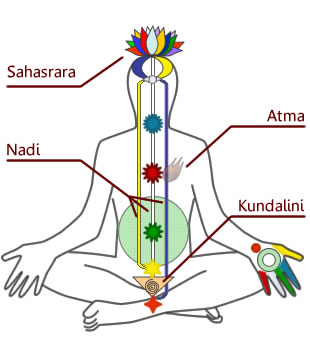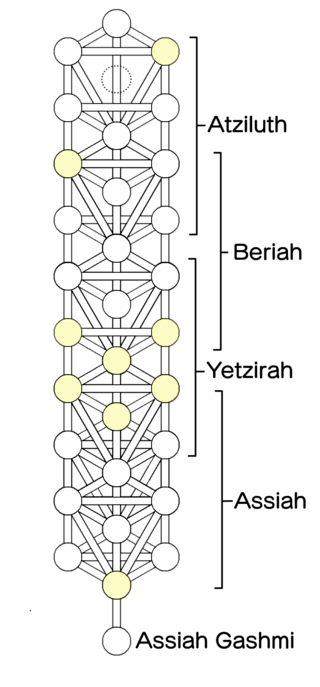
In Hinduism, kundalini is a form of divine feminine energy believed to be located at the base of the spine, in the muladhara. It is an important concept in Śhaiva Tantra, where it is believed to be a force or power associated with the divine feminine or the formless aspect of the Goddess. This energy in the body, when cultivated and awakened through tantric practice, is believed to lead to spiritual liberation. Kuṇḍalinī is associated with the goddess Parvati or Adi Parashakti, the supreme being in Shaktism, and with the goddesses Bhairavi and Kubjika. The term, along with practices associated with it, was adopted into Hatha Yoga in the 9th century. It has since then been adopted into other forms of Hinduism as well as modern spirituality and New Age thought.

Meher Baba was an Indian spiritual master who said he was the Avatar, or God in human form, of the age. A spiritual figure of the 20th century, he had a following of hundreds of thousands of people, mostly in India, with a smaller number of followers in North America, Europe, South America, and Australia.

Astral projection is a term used in esotericism to describe an intentional out-of-body experience (OBE) that assumes the existence of a subtle body, known as the astral body or body of light, through which consciousness can function separately from the physical body and travel throughout the astral plane.
Satguru, or sadguru, means a "true guru" in Sanskrit. The term is distinguished from other forms of gurus, such as musical instructors, scriptural teachers, parents, and so on. A satguru has some special characteristics that are not found in any other types of spiritual guru. Satguru is a title given specifically only to an enlightened rishi or sant whose life's purpose is to guide the initiated shishya on the spiritual path, the summation of which is the realization of the Self through realization of God.

The astral plane, also called the astral realm or the astral world, is a plane of existence postulated by classical, medieval, oriental, esoteric, and New Age philosophies and mystery religions. It is the world of the celestial spheres, crossed by the soul in its astral body on the way to being born and after death, and is generally believed to be populated by angels, spirits or other immaterial beings. In the late 19th and early 20th century the term was popularised by Theosophy and neo-Rosicrucianism.
In esoteric cosmology, a plane is conceived as a subtle state, level, or region of reality, each plane corresponding to some type, kind, or category of being.
The term involution has various meanings. In some instances it refers to a process prior to evolution which gives rise to the cosmos, in others it is an aspect of evolution, and in still others it is a process that follows the completion of evolution in the human form.

Sefirot, meaning emanations, are the 10 attributes/emanations in Kabbalah, through which Ein Sof reveals itself and continuously creates both the physical realm and the seder hishtalshelut. The term is alternatively transliterated into English as sephirot/sephiroth, singular sefira/sephirah.

Integral yoga, sometimes also called supramental yoga, is the yoga-based philosophy and practice of Sri Aurobindo and The Mother. Central to Integral yoga is the idea that Spirit manifests itself in a process of involution, meanwhile forgetting its origins. The reverse process of evolution is driven toward a complete manifestation of spirit.
"The Over-Soul" is an essay by Ralph Waldo Emerson first published in 1841. With the human soul as its overriding subject, several general themes are treated: (1) the existence and nature of the human soul; (2) the relationship between the soul and the personal ego; (3) the relationship of one human soul to another; and (4) the relationship of the human soul to God. The influence of Eastern religions, including Vedanta, is plainly evident, but the essay also develops ideas long present in the Western philosophical canon and the theology of Emanuel Swedenborg.

God in a Pill? Meher Baba on L.S.D. and The High Roads was a 1966 pamphlet containing messages from Meher Baba speaking out against taking drugs such as marijuana and LSD, ultimately saying they were harmful "physically, mentally, and spiritually."
Videha mukti refers to the moksha after death. It is a concept found in Hinduism and Jainism in relation to ending the samsara. The concept contrasts with Jivanmukti, which refers to achieving "liberation while alive". The concepts of Jivanmukta and Videhamukta are particularly discussed in Vedanta and Yoga schools of Hindu philosophy.
Perfect Master is the English term Meher Baba began to use in his writing as early as 1925 to denote the Eastern idea of a sadguru (Vedanta) or a qutub (Sufism). A Perfect Master, according to Baba, is a God-realized person who can use his Divine attributes of Infinite Power, Knowledge and Bliss for the spiritual upliftment of others. In describing Meher Baba's specialized use of the term Charles Purdom writes, "The title ‘Perfect Master’ ... means one who has himself reached the goal to which he directs others: one who, pointing to God, has himself realized God."

The Four Worlds, sometimes counted with a primordial world, Adam Kadmon, and called the Five Worlds, are the comprehensive categories of spiritual realms in Kabbalah in a descending chain of existence.

The tattvas in Indian philosophy are elements or principles of reality. Tattvas are the basic concepts to understand the nature of absolute, the souls and the universe in Samkhya and Shaivite philosophies. Samkhya philosophy lists 25 tattvas while later Shaivite philosophies extend the number to 36.
This is a glossary of terms used in New Thought.

Pratyabhijñā or Pratyabhigyā is an idealistic, monistic, and theistic school of philosophy in Kashmir Shaivism which originated in the ninth century CE. The term Trika was used by Abhinavagupta to represent the whole of Kashmir Shaivism, or to designate the Pratyabhijñā system.
Taijasa, which means endowed with light, is one of the many different levels of existence which the Jiva experiences due to the activity of Maya; it is the second of the three stages of consciousness that are part of the individual order of the Jiva. The three stages of consciousness are – 1) Vishva or Vaisvanara or the waking stage characterized by the individual gross body or sthula-sarira, 2) Taijasa or the dream consciousness which has the subtle body or suksma-sarira as its object, and 3) Pragyana or the deep sleep consciousness which is the unified undifferentiated consciousness or pragyanaaghana and the characteristic of the blissful causal body, the ultimate experience of Brahman.
Chidākāsha in which all gross and subtle activities of the consciousness take place; it is the sky of consciousness, everything dies and evaporates in this space of consciousness, everything is reduced to its essence in this space. Even the mind, along with intellect and ego, merges in this space of unconditioned Pure Consciousness through the paths of devotion, knowledge and action. It is also associated with the ajna chakra, the guru chakra, positioned in the stomata behind the centre of the forehead.

Atmabodha Upanishad or Atmabodhopanishad is one of the 108 Upanishadic Hindu scriptures, written in Sanskrit. It is one of the 10 Upanishads associated with the Rigveda. It is a general (Samanya) or Vedanta Upanishad.














